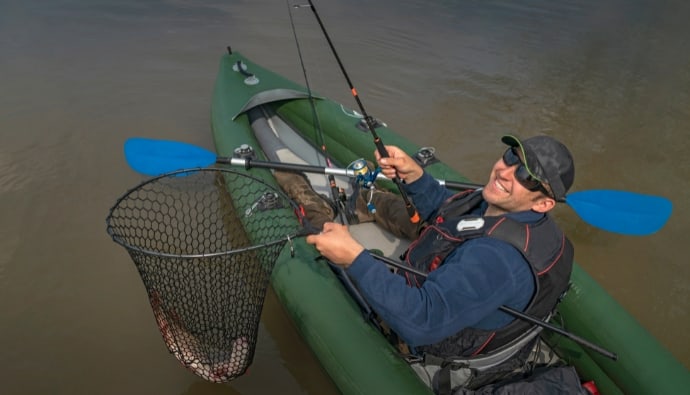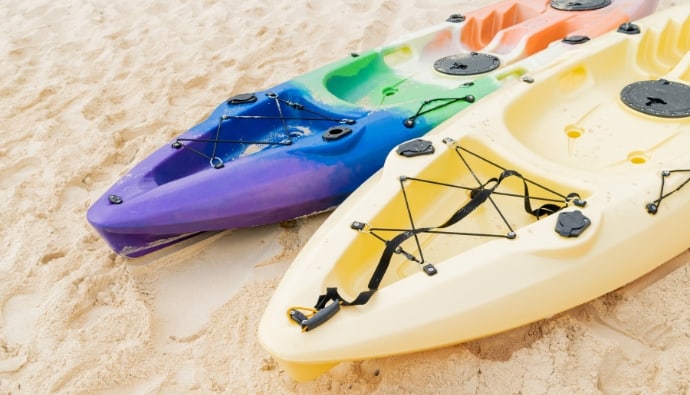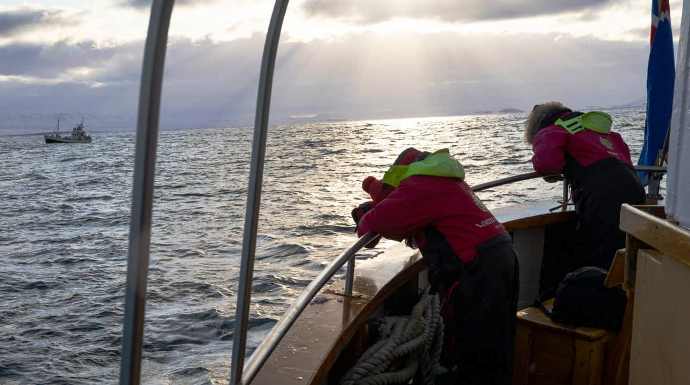Kayak fishing has always been a very famous pursuit for anglers, beginners, and seasoned ones alike. Although it might be daunting in the beginning, it can also be a very enjoyable activity.
This article will provide anglers with kayak fishing tips based on my podcasts with Anthony Esposito.

Kayak Fishing Fundamentals (What Beginners Should Know About Kayak Fishing)
Learn to Paddle
Riding a kayak on lakes is one thing. Knowing how to paddle it is another. Kayak fishing is different from boat or canoe fishing. When we compare canoe vs kayak fishing, a canoe has a single-blade paddle while a kayak uses only a two-bladed paddle.
But I mean, how hard can paddling be, right? According to Anthony, the moment he rode the kayak again when his uncle invited him to fishing, he fell out. He tried to turn the kayak around, but instead of using a paddle, he leaned, resulting in a sharper turn and a tumble into the water.
So, one of the kayak fishing tips you should never forget is to keep your torso and head centered with the kayak.
Once you move away from that center line, falling over is an instant probability. If you’re new to catching fish with a kayak, you might think that having a wider kayak means more stability. However, that’s not necessarily true.
Although it does provide more stability on flat water, you will want the kayak to stay parallel with the surface when you go into rigorous waters.
You’ll Get Wet
Everyone knows how small most fishing kayaks can be, and if you haven’t mastered the art of balance, expect to fall off anytime.
There is no such thing as dry kayak fishing, even if you’re a seasoned angler. Getting wet is part of the deal when doing this activity, especially when paddling through rough waters.
Water will splash at you everywhere, and it’s easy to lose your balance when your rod gives you a strong tug from smallmouth bass.
It’s also best not to wear cotton clothes when kayak fishing, specifically sweatshirts, and jeans since they’re water-absorbent. It will only weigh the fishing kayak down.
Anthony says it’s better to have only a few layers that easily dry up. A windbreaker is ideal on trips like this, especially during cold days.
You’ll Lose Things
Always expect to lose some of your fishing gear when kayak fishing, which is why it’s important to always have them strapped down. Conceal the stuff you don’t want water on, no matter where you can keep it.
You can place it on waterproof pockets or a hatch in your kayak to make sure it doesn’t get wet. Another thing is to try and strap down important items in case you might accidentally flip your kayak. You don’t want to find your wallet at the bottom of the water.
Additionally, try not to conceal your rods and reels while being in open water. But if you’re going through rough water or when you’re launching, it’s always best to keep them strapped down. Some kayaks have hatches inside, which you can use to keep your belongings.
There’s No Perfect Kayak
Most kayaks have their own uniqueness. There isn’t one perfect kayak you can simply choose. There’s only one suitable for a particular scenario, no matter what you plan on doing. There are various body water types, including rivers, streams, bays, lakes, and the ocean.
Most expert kayakers will want one that’s long, narrow, and fast when going to the ocean. At the same time, short kayaks are more suitable for freshwater kayak fishing in rivers and lakes since they’re easier to turn.
If you’re still a beginner, it would be best to test some fishing kayaks out before actually purchasing ones to find one you want to work with. You can rent some out or borrow from a friend.
Take note that no kayak can perform excellently in any body of water. However, some would take the spotlight in one or two categories, mostly lakes, and the ocean.
Know Your Regulations
It’s best to know your regulations when you finally decide to purchase a kayak for yourself. Most of the time, kayaks with motors or an outboard need a CF number with a DMV registration.
However, if you plan on buying one that isn’t powered by power, registration isn’t necessary. It can be a promising option since you can also have a sail-powered kayak to let the wind do the work if you get tired of rowing.
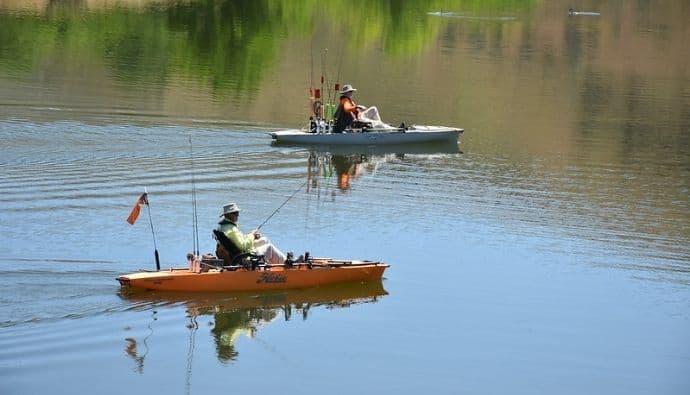
Picking Your First Kayak
Now it’s time to pick your first kayak. How do you make sure you find the one for you? Here are a few things to keep in mind to help you choose the best fishing kayaks.
Based on Fishery
If you’re still testing out kayak fishing, it’s better to try out rentals first before actually buying a fishing kayak.
Although you might be into it now, you might lose interest after a few tries and end up selling your kayak. Used ones are a good option too.
Other than them being cheaper, they are also a promising small investment, especially if you decide to opt-out since you don’t enjoy catching fish as much. Among the kayak fishing tips is that anglers prefer to sit in kayaks with rod holders.
Use
As mentioned, you don’t need a long kayak when fishing in a river or lake since you don’t have any waves to battle. You will want a wider and shorter kayak if you want to fish in rivers since they’re easier to control and maneuver than long ones.
As for choosing the best ocean kayaks, try not to go down anything below 13 feet. It’ll be harder to fish.
Paddle vs. Pedal
You can choose a fishing kayak not powered by a motor if you want to stray away from getting it registered. However, that’s not where your choices end.
Although a fishing kayak with a pedal for propulsion may sound more convenient, it does take away internal storage. Also, an internal rod sword might not always be the best thing either since it takes away flexibility.
Paddling is a good way to exercise, so even if you have a pedal-powered kayak, it’s still best to keep a paddle around.
Budget
You don’t have to buy a brand-new fishing kayak if you’re tight on a budget. As mentioned, you can buy a second-hand one, rent it, or borrow it from a friend.
Most used kayaks range from 300 to 600 dollars, depending on the type.
Also, it’s best not to buy a kayak on a whim, even if you have the budget. You’re doing yourself a disservice when you don’t check out the other options on the market.
Who knows? You might find a better one for a lower price.
Where to Find One
You can look it up online or ask some friends if they know any trusted sellers. Several websites feature used kayaks. Some of them also sell a brand new kayak if you really want to be the first user.
Others also give away free paddle or rod holders, so make sure you get your dollars’ worth. Spending time on a paddling kayak can be worthwhile.
What Comes With
If you’re planning to buy a used fishing kayak, you might as well go with the one with lots of freebies. Some sellers include a fish finder or any additional electronics once purchased.
It’s also best to choose something that already has some installations instead of trying to do the kayak fishing rigging yourself. You don’t want to risk damaging it, making you lose some fish. Others might even include a rod holder or a feature that ensures basic functionalities.
Conditions to Look For
If you get a used one, make sure to check if it has holes properly. You can fill it up with water, place it on water, or use a flashlight and see if the light gets through the other end.
You’ll have to talk to the seller as well if they agree to the terms. Despite its damage, make sure it can still function properly while catching trout.
How Was it Used
Always inquire about the usage of the kayak you’re about to purchase. Take note to ask how often it was used and where, when it was bought, or any accidents with the kayak.
Remember that sit-in kayaks are different from sit on ones (here’s how to look for the best sit on top kayaks). Plenty of people enjoy casting with the latter while getting their anchor down.
Transportation
You can choose a fishing kayak that’s light and small for easy transportation. If you decide to go fishing by yourself, do you think you can load it up by yourself? The best inflatable fishing kayak might be worth looking into.
Your vehicle is also a factor when it comes to transportation. With a smaller automobile, long and wide kayaks might solve the problem.
Picking Your Paddle
As for paddles, it will be dependent on your stroke, ability, size, and the type of kayak being used. But the bottom line is to prioritize the paddle. That’s the motor, after all.
As for European (flat-bladed) style paddles, I’d recommend Werner. All of the big kayak brands make really nice paddles, but the model is going to vary from angler to angler.
A decent flat-blade paddle will cost around 150-200 bucks, and a really nice paddle will probably run from 300-450 bucks, usually depending on materials (plastic, fiberglass, bamboo, carbon fiber.). These are the standard style paddles most American anglers use.
As for Anthony, he prefers a high-angle paddle like the Tybee over low-angle paddles like the Kaliste. He also prefers a straight shaft to a bent shaft. He has used both extensively.
Additionally, if you paddle a really narrow kayak like 27″ or narrower and care about speed and thrust and want a more sporty option, you may want a wing paddle.
EPIC, RPC3, and a few other companies make nice ones, but because they’re a little more specialized and you won’t find them at a normal kayak/sup shop but at a dedicated racing kayak/surf ski shop. Expect to pay a minimum of 275 bucks for a name-brand paddle and up to about 600 for a full carbon race paddle.
I would probably not recommend this for a new paddler or really anyone who doesn’t prioritize speed and acceleration over everything else because it requires a more technical and higher-angle stroke.
One would not be able to use this paddle on anything over 30 or so inches cause they’re typically shorter than European-style paddles because they’re made for skis that are 23-27″ wide.
There is also what’s known as a Greenland paddle. I don’t think I’ve ever seen one in person. They’re more common in touring sit-inside sea kayaks.

Kayak Safety 101
Listen to this post on the Cast & Spear Podcast
Equipment
Safety is a priority no matter what activity you’re doing, which is why a PFD (personal flotation device) is a must-have when kayak fishing—another crucial thing to have while on the water is a radio.
Make sure to get a waterproof one and one that floats. If it doesn’t, you’ll have to make sure it’s latched on you.
A PLB (personal locator beacon) is an absolutely essential tool when you get lost in the ocean in the dark. PLBs collect users’ personal data or their personal information by pinning their location.
Don’t worry; they procure user consent prior application of their security features on you. Whether you’re on a boat or on a mountain, the PLB can locate you anywhere.
Knowledge and Procedures
First, you’ll want to wear your PFD; make sure it’s a snug fit. Next, get your radio prepared and read the manual if you’re not sure how it works. You can also look up preparation videos on Youtube when it comes to kayak fishing.
Make sure you also know how to keep the kayak upright as kayak fishing 101. You can practice turning a few times on shallow water before going on your trip. Lastly, always let someone know where you’re going when you plan to go on a paddling trip.
Keep Your Eyes Open
You will never know the circumstances you might encounter while kayak fishing, which is why a first aid kit is important.
If ever you accidentally get bitten by an animal or hook yourself, you will need to stop the bleeding. Moreover, it’s best to carry some Dramamine with you to fight off the motion sickness if it’s your first time. Lily pads can disrupt paddling too.
What to Avoid
A compass is a must-have when kayak fishing in the open sea. However, make sure not to place it anywhere near metallic, such as your belt buckle. The magnetism can get disrupted and won’t accurately point north.
Another is always having a cord or rope with you to anchor your kayak or tie it to a dock. You can either use a folding anchor or an anchor line for convenience.
Test Biting
If ever you see a dead animal on your way, avoid going near them at all costs. There might be sharks or other predators lurking nearby, and most of the time, they often do test-bite anything near the dead animal. They often can’t tell which is food or not until they bite it.
Getting Close to the Rocks
Rocks can be hard to avoid when kayak fishing in rivers because of the strong current. However, if you encounter this, you’ll want to lean toward the rock instead of away from it. If you lean away from the current, it gathers upon your edge and flips you over.
If you lean downstream into the rock, though, the current will go under. You’re providing it with a passage under the kayak, ensuring an upright position to keep you above the lake water.
Chasing Birds
Where there are birds, there are fish. Kayak fishing is making the most of your senses in the open wild. Because of their height on the water and the ability to swiftly approach these birds, kayak anglers are disadvantaged when seeking bird schools.
Anglers may frequently pursue a bird school only to discover that the birds are merely feasting on a carcass or rubbish. This is never a pleasurable experience, but it may be prevented with a little preparation.
Carry a Paddle
You might have a pedal drive, but it’s always still best to have a paddle with you. For instance, when you accidentally flip and lose your drive, therefore losing the ability to get back to shore.
Also, it’s best to latch your paddle to the fishing kayak to make sure you don’t accidentally lose it. A paddle leash does that job swell.
Buddy System
If you plan on going kayak fishing on your own, make sure you’ve told someone about it. Letting your partner or a friend know where you’ve gone can ensure your safety if anything happens on your paddling trip to fish.
But when it comes to kayak fishing in winter, it’s important that you bring a buddy with you. Having another pair of hands and eyes helps you overcome any challenges.
Best 2 of 3 Rule
According to Anthony, there are three things that an angler should have ideally, but two of them are necessary.
One is weather conditions; the second is a buddy to go kayak fishing with. The third is an intimate knowledge of where you want to spend your time casting for fish. If you have two of the mentioned, you’ll most likely have a safe and fun adventure.
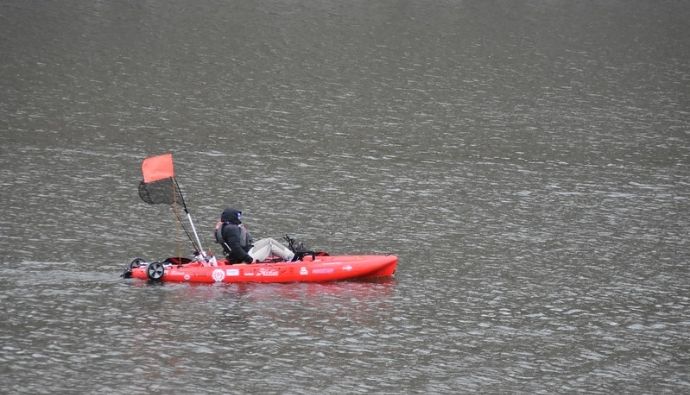
Kayak Fishing Gear & Tackle Recommendations
You might be new to kayak fishing, and you’re like, what do I need in my tackle box to give me a chance at bringing home my first catch? No worries. We’ve listed our recommended kayak fishing gear to help you.
Tackle
Every angler understands the value of a well-stocked tackle box. A fishing rod is only as good as the bait and tackles it using. On a casting vacation, you can bring your costly, high-quality fishing pole, but without anything to place on your hook end, you’ll barely catch fish. The perfect rod is the length of an arm span.
A hard tackle box is what it sounds like. It features a hard (synthetic material) exterior with storage and compartment spaces on the inside. Although old tackle boxes were built of metal or even wood, most current tackle boxes are tough plastic. They are perfect for keeping small or big fish on a boat or kayak. Get the perfect tackle for all the bass you fish.
Tools
Pliers are an absolute must when going fishing. Another useful tool is fish grips for most anglers, especially in pulling the hooks out. They help you hold the fish without actually having to touch it.
Additionally, despite knives being sharp, line cutters are more efficient compared to pliers or knives for your fishing line.
Having a net, as well, is mandatory, with a minimum opening of 18 inches. A measuring board is also necessary when going fishing.
According to Anthony, not bringing one with you will violate the dishing rules of California sports. Folding anchors are also quite useful when fishing on a lake.
Live Bait
The best bait is always live bait when it comes to saltwater anglers. The first issue is the storage of live bait. In a bucket with a battery-powered aerator, some baitfish will live. Install a store-bought Livewell or put up a three-gallon bucket or small cooler with an in-flowing water line and overflow drain for more fragile fish.
Run water into the Livewell using a tiny bilge pump connected to a lithium-ion battery and let gravity carry it out.
Electronics
Below are some useful fishing accessories and gear you should take with you, whether on a kayak or boat.
1. GPS: A Global Positioning System allows you to return to your favorite locations or go back to where you first went.
2. VHF Radio: A VHF radio is not only useful for receiving up-to-date weather notifications, but it is also useful in a rescue emergency.
3. Kayak Fish Finder: Although it isn’t usually used to discover fish, it will echolocate the bottom of any body of water and create a picture of what it looks like.
4. Portable Power Bank: When catching fish with several electronics such as GPS units, cameras, phones, and other devices, a portable power bank may be quite useful.
Fish Storage
Several ways may be used to preserve and keep fish fresh during kayak fishing, especially bass fish. Stringers, tank wells, hatches, keep nets, soft coolers, and even hard coolers will help keep a catch fresh for a day. However, they are more difficult to use than on a bigger craft, but you can also store more fish.
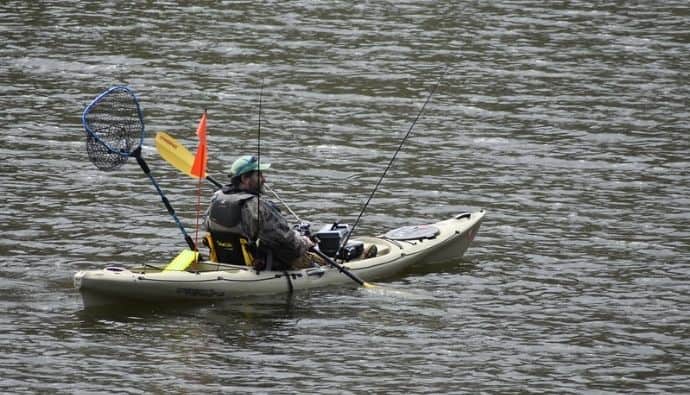
How to Launch From the Surf (Kayak Fishing 101)
Cove
If you’re in a cove that protects you from a coming swell from the south, you will most likely be okay, even if the cove is open on the west and north.
If one day you plan on launching from Carlsbad or Huntington beach, you will essentially need to learn to stuff. It will help you avoid accidentally losing your stuff. Or you could simply do casting off the coast and might even fish some bass.
Shelters
You can take shelter on some beaches. Several protected beaches, such as the LA Jolla, keep big surfs away due to their geography. If you don’t feel comfortable doing a service launch, you can launch out of harbors or boat ramps. If the waves are too big for a kayak, you can fish from a boat instead and catch bass.
Beach
When doing a service launch, it’s important to learn some surfer ways. Below is a series of steps for doing your first-serve launch with moderate waves.
- Understanding the surf
- Knowing your spot’s geography
- Knowing where you want to launch
- Reading the swells and tide charts
- Knowing their directions
- Observing their periods
- Learning the height of the swells and sets
Timing
When you’re standing on the beach and observing sets, make sure to wait for that low between the sets. If you see a few rollers come in and some smaller waves, that’s the time you should go. Try not to hesitate. Getting it only done halfway will result in waves catching your kayak sideways or in the stern, leaving you a bad day.
Technique
One important thing to remember is that you can’t sit on your kayak in shallow water, so you have to go out waist-deep and hop into it. Once you go out, make sure to keep your bow in the surf and charge through.
If a big wave comes, you can wait a bit and let the wave crash, so you only tread through whitewater. However, try your best not to let it catch you sideways. Correct yourself the moment you realize you’re starting to drift.
Backing in or Forward
The principle is keeping your bow faced to the waves as if you’re launching. And when the waves begin moving towards you, you can more easily paddle forward than backward if a big wave pushes you back.
To explain further what Anthony said, you need to gain momentum when going forward into the wave. Let the wave break and continue in, gradually moving backward instead of allowing the wave to catch the stern.
Gear Storage
Make sure your kayak has a lot of storage capacity and can carry a lot of weight. After all, you’re not only carrying your kayak fishing gear onto the water but also your fishing equipment.
Several fishing kayaks are available, equipped with mounting gear, additional storage compartments, and rod holders. For snacks, while casting, you can wear a coat pocket that includes cookies on the trip.
What I Wish Someone had Told Me Earlier
Kayaking is not cheap
Although you can purchase a used fishing kayak and equipment, it’s still like any other hobby. When you’re fully passionate about it, you will want to spend more on it.
You will replace many things when you accidentally lose them overboard, or some might break after getting wet. Fishing accessories alone, especially rod holders, can be extra money in your wallet.
Poor man’s boat
According to Anthony, a kayak isn’t a poor man’s boat. Although it’s more limited than actual boats, you can still do several things in a kayak as one of the kayak anglers. Most of the time, it’s due to preference and a different experience.
The physical workout when kayaking compared to boats is also a significant aspect for those who prefer mixing fitness and fishing together.
Breakdown
If you get your gear wet during your kayak fishing trip, you can rinse them under the sink or use a spray bottle. Using a hose or submerging it in freshwater often forces water to get inside, further causing an internal breakdown as time passes.
After rinsing, make sure to wipe it dry to avoid getting water inside. Additionally, try to be susceptible to corrosion in some of your gear, especially your rods, and reels.
Lost and damaged
Losing things while kayak fishing is inevitable, which is why tying most of your equipment and gear down is an essential step. You will have to replace all the things you lost, especially if they’re safety equipment.
For damaged items, you can visit a fishing shop and have them serviced. Make sure to have your rod holder maintained; you don’t want to lose your fish.
Ignore most of the hype
Even if a kayak is cheaper than a boat, it’s still quite an expense. Try not to get carried away by the hype. As exciting as it may be, especially after seeing videos on Youtube, it’s still dangerous and expensive.
It’s better to keep a level head when heading out into the water and to buy the necessary gear and equipment. Take note to only buy those that you need, or you’ll end up broke from letting the hype carry you away.




 Facebook
Facebook YouTube
YouTube